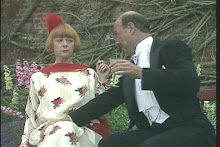Theme: survival
Lady Jane Grey's prayerbook, believed to be the one she carried to the scaffold. The pale writing at the bottom is a farewell message in her own hand to the lieutenant of the Tower, adjuring him to obey God's laws. (
Image from the British Library online gallery.)
July 6: execution of Thomas More, 1535; death of Edward VI, 1553July 10: proclamation of Jane Grey queen, 1553July 12: Divorce of Henry VIII and Anne of Cleves, 1540; marriage of Henry to Catherine Parr, 1543July 19: Proclamation of Mary Tudor queen, 1553July 26: Marriage of Queen Mary to King Philip of Spain, 1554July 29: Defeat of the Spanish armada, 1588Political events moved quickly in an age when royalty -- and its henchmen -- still governed by divine right. Lady Jane Grey's famous nine days as Queen (she was a scion of the Tudor family through her descent from one of Henry VIII's sisters) sped by in mid-July, 1553, after the death of the teenaged king, Henry's long sought son, Edward. In quieter times July would be a month for the royal court to begin its summer progresses to freshly cleaned rural mansions. Smallpox, the plague, and the mysterious "Sweat" were the scourges of the season, especially in London. Filth, sickness, vermin, and bad teeth were a part of all people's lives to an extent that we can hardly imagine. So was hunger and the fear of hunger. In the country, a supply of beef and mutton would already have been slaughtered at midsummer, and would have to last, salted, till winter. St. Swithin's Day, July 15th, was a day for the farmer to look at the sky with apprehension: rain on this day was thought to mean a rainy summer and possibly a spoiled harvest.
Sources:
Emmison, F.G.
Tudor Secretary: Sir William Petre at Court and Home. London and Chichester: Phillimore & Co. Ltd., 1970 (first published by Longmans, Green, and Co., 1961) p. 239
Ibid, p. 253
Fussell, George Edwin.
The English Rural Labourer: His Home, Furniture, Clothing, and Food from Tudor to Victorian Times. Westport, CT: Greenwood Press, 1975 (originally published by the Batchworth Press, London, 1949), p. 27.
Cressy, David.
Bonfires and Bells: National Memory and the Protestant Calendar in Elizabethan and Stuart England. Berkeley and Los Angeles: University of California Press, 1989, p. 28.


































